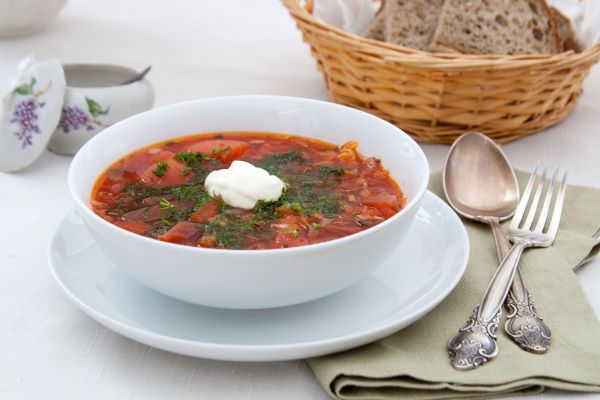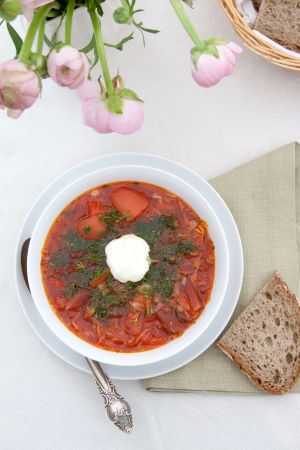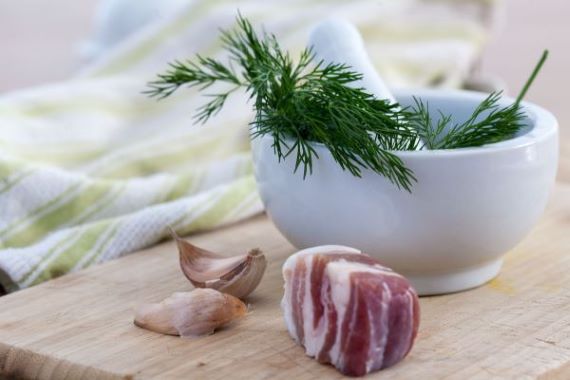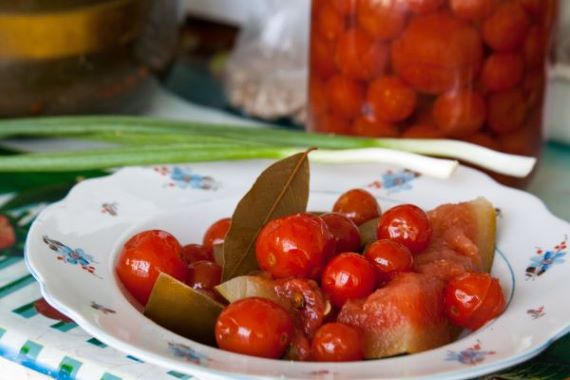You can spell it borscht, borshch, or borsch, but by any name, it’s the dish that embodies the essence of Ukrainian food culture–colorful, rich and vibrant. To call it soup wouldn’t be correct, because Ukrainian borscht is a dish more like minestrone, pot-au-feu or cocido in its heartiness. Every region of Ukraine has different varieties of borscht. There is no one authentic recipe, although there are classical versions. Borscht in Lviv in the west of Ukraine is ruby-red and includes small mushroom-filled dumplings; it’s an essential Christmas Eve dish. In the south of Ukraine, borscht is made with fish. The Central Ukrainian-style borscht–the most popular variation–is famous for its sweet-sour flavors. Borscht can be made with beef, pork, chicken, duck, beans, and even fish. It can be vegetarian. It can be soured with tomatoes, beet kvas, vinegar, sour cherries, rhubarb or red currants. It can be flavored with mushrooms or dried plums. It can include white beets and be pale in color. It can be spicy with paprika or suave with sour cream.

Outside of Eastern Europe, borscht tends to be associated with Russian cooking, since people tend to label everything from the former Soviet Union as Russian. Borscht in different variations is also enjoyed in Poland (barszcz), Lithuania (barščiai) and Romania (borş). Nevertheless, if you think of borscht as soup with beets, cabbage and tinted red with tomatoes, then it’s the Ukrainian version that you have in mind. According to the Russian food historian, Olga Syutkina, that version became popular in Russia at the end of the 18th century, when this dish was introduced on the tsarist army’s menu. Originally, borscht was the food of the peasants, because it was easy to cook in advance and was nutritious enough to be served as a one-dish meal. With the immigration of the Ashkenazi Jewish community to North America, borscht–the English spelling gives away its Yiddish roots–became popular in the New World.


Given that the dish has so much cultural significance, Ukrainians tend to be categorical about the way to cook borscht. Does one add beans? Which type of beet to use? Can you add sauerkraut to your borscht? These types of questions can result in explosive discussions. Consider that the battleship Potemkin mutiny that led to the October Revolution of 1917 was caused by a pot of badly cooked borscht. Ukrainian borscht exists in numerous variations, but certain things hold true: it includes beets; it can have meat, but vegetables are the most important component; it’s thick; it has a balanced sweet-sour taste. Obviously, the borscht made by one’s grandmother always tastes the best, and so I would like to share my grandmother’s recipe with you.
My mother’s family is from Poltava, central Ukraine, which is famous for its variety of borscht made with poultry (chicken, or much rarer, duck.) My grandmother uses poultry and pork together, since it makes the taste more complex. She uses lots of tomatoes and a modest amount of beet to avoid too much earthiness. She chooses mild-flavored vegetables to make sure that the final dish is harmonious, with each component retaining its natural taste. She relies on the acidity of fermented tomatoes to give the right level of sourness and she adds a pinch of sugar. The garnish is always the same–lots of sour cream.
My Grandmother’s Poltava-Style Borscht, the Classical Version
6-8 servings
The Poltava-style borscht is sweet-savory, rather than aggressively sour. So, it needs no vinegar or lemon juice. My grandmother uses fermented tomatoes, for which I will include a recipe below. You can skip them. The natural acidity from fresh tomatoes should be enough. The classical accompaniment to borscht in Poltava is pampushky, soft garlic buns.
If you don’t eat pork, increase the quantity of chicken or include a piece of beef (shank, bavette, or any other good stewing cut). Skip the salted pork and increase the quantity of oil to 2-3 Tablespoons.
The Pounded Paste can also be made in a larger quantity and used as a spread on bread. It’s addictive.
Vegetarian version: skip the meat and salted pork. Soak 1/3 cup white beans overnight and boil them in 12 cups of water with 1 chopped onion and 2-3 dried mushrooms. Once the beans are soft, proceed with the rest of the recipe (you will need to add extra water in the process of cooking.)
12 cups water
2 chicken thighs and 2 drumsticks, separated
250g pork ribs, cut along the ribs
1 large onion
1 medium carrot
1 medium beet
1/2 red bell pepper
1 dried medium-hot red chili, ground black pepper, salt, to taste
3-4 floury potatoes
1 bay leaf
1 T vegetable oil (sunflower, grapeseed, peanut)
1 medium slice salted pork fat (unsmoked bacon, pancetta or lardo work well)
1 T flour
3 medium tomatoes, chopped or 1.5 cups of good quality canned tomatoes
1 fermented tomato (optional, see note)
pinch of sugar (or to taste)
1/4 white cabbage
Pounded Paste:
1 small slice salted pork fat (unsmoked bacon, pancetta or lardo work well)
2 garlic cloves
2 T of minced dill and parsley
To serve: sour cream and more minced herbs
Rinse your choice of meat well, cover with water and bring to boil. Turn the heat down to simmer, skim off any foam and cook till the meat is tender. Modern chicken cooks very fast, so I remove it after about 40 minutes. If water evaporates too much, add a bit more boiling water. Cook till the pork is soft.

Meanwhile, cut the onion into small cubes. Slice the carrot and beet into medium-thick slices and then cut them into thick julienne. Cut the red bell pepper into medium cubes. Add 1 teaspoon of ground black pepper, mix well and leave to marinate. (You can change the proportion of vegetables to your taste. Whatever you do, borscht needs to be thick. Think of it like a hearty Italian minestrone.)
Peel 3-4 potatoes and cut into large cubes. When the meat is soft, add to the simmering broth. When potatoes are tender, add the marinated vegetables, dried chili pepper, 1 bay leave and 1 teaspoon of salt.


Melt the pork fat in vegetable oil, add 1 T of flour and stir till it becomes beige. Add fresh tomatoes, fermented tomatoes (if using) and a pinch of sugar. Simmer for 10 minutes. Add to the broth. (Return the chicken that you had taken out earlier to the broth.) Add salt and pepper to taste. Slice 1/4 white cabbage into fine julienne and add to the broth. We like our cabbage to have a slight crunch, so we cook it for 5-10 min only.

In a mortar, pound the remaining pork fat, 2 garlic cloves and herbs. The ingredients can also be chopped. Add to the borscht, let it simmer for a minute and remove off the heat. Serve with sour cream and more chopped herbs.
Fermented Tomatoes (for the ambitious cooks among you)

Into a clean, sterilized jar, add tomatoes, garlic slices, dill springs, 1 bay leaf, black peppercorns (in Ukraine, we also use cherry leaves and black currant leaves in pickles.) Top with boiled and cooled water. Weigh tomatoes and water and calculate 4% of that. That’s the quantity of salt you need to add. You can also go by taste–the water should taste as salty as sea water. Leave for 4 days at room temperature to ferment and then store in the fridge or in a cool space. You can eat tomatoes as a side dish as well as use them in cooking. They add a complex tart-fruity flavor to soups, sauces and stews. If the liquid turns cloudy, it’s a good sign that the lactofermentation is under way. If a white film appears, it’s a type of wild yeast and it’s harmless, but it’s best to remove it so that it doesn’t affect the flavor.
Photography by Bois de Jasmin













46 Comments
Tourmaline: Dear Victoria,
Thank you for this great post. It is late at night here, and I have become hungry reading it. I am reminded of a beef and vegetable stew that I used to make, in which the beetroot turned the potatoes and pumpkin gorgeous shades of sunset pink!
I would like to try this recipe using plain tomatoes and beans, as I don’t eat meat very often these days. I want to try making sauerkraut sometime as well – good for the gut.
Our SBS TV website in Australia has many recipes by Ukrainian lady, Olia Hercules. Here is a link to an article from August 12 2020 about her third cookbook.
https://www.sbs.com.au/food/article/2020/08/12/find-cabbage-dish-your-dreams-ukrainian-cuisine
With kind regards,
Tourmaline November 9, 2020 at 8:32am
Zuzanna: I make a vegetarian version with red lentils, it’s delicious, too. It’s clever to use a vegetable broth instead of water, with a tomato and mushrooms/ champignons, to add the umami taste! November 9, 2020 at 9:27am
Tourmaline: Thanks for the tip, Zuzanna. I love mushrooms, and that whole umami flavour. November 9, 2020 at 9:31am
Victoria: My grandmother grinds dried porcini mushrooms to fine powder and uses it in various dish for a flavor boost. November 9, 2020 at 10:06am
Tourmaline: That’s a great idea. There is a brand of mushroom pizza that I find quite addictive, and I’m sure it’s the umami flavour. November 9, 2020 at 6:56pm
Victoria: That sounds really good! November 9, 2020 at 10:05am
Mark: Thanks for the recipes and the link.
When I want an extra umami punch, I use dry shiitake mushroom powder that I make by pulverizing whole dried in a blender. It’s how I boosted the flavor of things without my children knowing that they were eating mushrooms. They now love mushrooms but I still use it when I don’t want pieces of mushrooms in a dish or it just needs some umami to push the flavor of the dish to its peak. May 7, 2021 at 12:44am
Tourmaline: P. S.
I remember seeing “Battleship Potemkin” for the first time back in 1979. at a film evening run by the English Department of the University Queensland. (Every week they screened old films from cinema history, including “The Cabinet of Dr Caligari” and “Nosferatu”.) The scene with the maggot-infested meat that was to be used in the Borshch has remained in my memory, along with that of the massacre on the Odessa Steps, although the latter apparently never happened. November 9, 2020 at 9:48am
Victoria: Apparently, the storming of the Winter Palace during filming caused far more damage than the actual events. I’ve never seen that film in its entirety, although I know the key scenes.
The Potemkin Stairs in Odessa are impressive, I have to say. When you stand at the bottom and look up, they appear as if they are stretching for miles. November 9, 2020 at 10:09am
Tourmaline: That’s very interesting; I must read about the filming.
It would be wonderful to see such a sight. Maybe one day! November 9, 2020 at 6:53pm
Victoria: Odesa is a beautiful city. I enjoyed my trip there a couple of years ago. November 10, 2020 at 11:52pm
Peter: Aloha Tourmaline. I also remember the iconic Odessa Steps scene. Especially the baby carriage! November 9, 2020 at 10:45pm
Tourmaline: Aloha Pekolo!
Oh yes, the baby carriage! So frightening…. November 9, 2020 at 10:59pm
Victoria: I was going to share my mother’s vegetarian version with mushrooms and beans, but the post was too long. I will write it out separately. If you want to try it, however, all you do is to replace meat broth with the broth made from boiling the beans (cannellini beans or white beans are our favorites) + one extra minced onion + 2-3 dried mushrooms. The rest is the same.
I also sometimes add beans to the meat version, which is common in our region. November 9, 2020 at 10:04am
Tourmaline: Thank you for the tip; I will definitely try that version. November 9, 2020 at 6:44pm
Victoria: You can use fresh mushrooms too, of course, but the dried ones are better. Or you can use the water from soaking dried mushrooms. November 10, 2020 at 11:52pm
Tourmaline: More great tips – thank you! November 11, 2020 at 1:47am
Rhinda: Thank you Victoria, Tourmaline, and Zuzanna for the meatless suggestions. The long ago me would have made it as you have written but I just began eating plant based 6 mos ago.
I will definitely try it! November 9, 2020 at 10:50am
Victoria: I’ve updated the recipe headnote. I often make it vegetarian. November 9, 2020 at 10:58am
Rhinda: Thank you!
My perfumes smells totally different since the drastic change in my diet! Some I like even more. November 9, 2020 at 11:20am
Victoria: That makes sense to me. Diet would have such an effect. November 9, 2020 at 3:45pm
CherieW: This is why we love your blog – food to please every sense! Thank you so much for the warm recipe from your family, just in time To comfort us in the coming cold season, one where many will have to miss being with their own families. November 9, 2020 at 11:31am
Victoria: Thank you! I hope that you enjoy it. 🙂 November 9, 2020 at 3:45pm
rainboweyes: Barszcz is one of my favourite winter soups… soulfood at its best 🙂
I mostly include some stripy tondo di chioggia beets and carrots in various colours (orange, yellow and purple) to add an extra splash of colour.
My mother also used to cook a spring variation called botwinka, which is made with baby beetroot, their tender leaves included. It’s garnished with boiled eggs. Worth trying too! November 9, 2020 at 3:24pm
Victoria: In Ukraine, different regions have different kinds of beets especially grown for borscht. My grandmother uses pale red ones. I should try Chioggia beets, thank you so much for the idea. I actually bought some today for a Georgian beet and pomegranate salad.
Botwinka sounds so good. I also make a summer borscht with beet leaves and zucchini, but your recipe is especially tempting since it’s served cold. November 9, 2020 at 3:48pm
Mel: This sounds so delicious! I can’t wait to make the vegetarian version w/ extra beans and mushrooms!
Also, Victoria, I loved your Gogol post – I always look forward to your book recommendations! November 9, 2020 at 5:12pm
Victoria: Oh, thank you so much. I will put together another reading list soon. November 10, 2020 at 11:51pm
Mel: I can’t tell you how many wonderful books I’ve discovered due to your recommendations and the comments/dialogues that follow! November 11, 2020 at 12:20am
Peter: Mahalo Victoria, for sharing your Grandmother’s Borscht recipe. I was raised in the 1960s with unpleasant canned beets. I’m finally giving fresh beets a taste. Your ‘sweet-savory’ recipe may convert me into a Beet Lover. November 9, 2020 at 10:40pm
Victoria: I’ve never tried canned beets, and I don’t think that I will. That doesn’t sound right. November 10, 2020 at 11:53pm
Qwendy: Hi Victoria, thanks so much for the recipe and family lore, it hits the spot! I will make it with duck because I live in France ;-). I just adore that idea!
Now I am curious about the Georgian beet and pomegranate salad, a fab combo …. is it Pkhali (thank you Google)? Is there a Georgian cookbook???
A happy and healthy fall to you oxox November 10, 2020 at 3:14am
Victoria: It was just a roasted beet salad, with pomegranates and walnuts. Almost like phkali, but in cubes.
And here you go:
https://boisdejasmin.com/2017/10/menu-for-a-georgian-feast-with-three-cookbook-reviews.html November 10, 2020 at 11:54pm
Qwendy: Thanks so much, how exciting! I have been cooking a lot from the Sami Tamimi Palestinian cookbook Falastin, which is fantastic, and I need to move on, perfect!
I have my tomatoes fermenting on the counter 😁 thanks again for such an inspiring post! xQ November 11, 2020 at 12:25pm
Victoria: I also loved Falastin. I rarely buy cookbooks these days, but I’m very happy with his.
Bravo! I hope that you’ll enjoy the recipe. You can use the tomatoes for borscht after a few days, but as they get sour, the flavor will be more intense. I usually keep a jar in the fridge especially for borscht. November 12, 2020 at 1:23am
Qwendy: Well I think the Georgian cookbook will be next on my list, grace a toi!
I adore condiments and I am really looking forward to experimenting with the tomatoes!
Xxx November 12, 2020 at 12:42pm
Tami: My grandparents were from Kars, now part of Turkey but under Russian control when they lived there; their parents fled the area for the US not long before the Revolution. Their borscht was a brown, beefy, cabbage-y affair that isn’t a beet soup per se, but had perhaps a beet IN it. I still have a church cookbook (in English—thankfully for me) that lists a few different recipes for it, each of which was certainly the right way to make it (to that family). I love this book and the personalities of each of the contributors shines in each of the recipes, especially the essay on how to brew a proper samovar of chi.
The first time I saw a jar of the purple beet soup with the bright BORSCHT label on it in a grocery store, I was quite perplexed! That was back when I was about five years old, and I still have the distinct memory of encountering on the end cap of a shopping aisle and asking my mom about it when we got home. I don’t see that around as much anymore, but it used to be pretty ubiquitous. November 18, 2020 at 12:57am
Tami: I should add, I love reading and learning about regional differences in recipes. It’s really special to discover the similarities and differences in how “the same” dish is prepared from place to place. November 18, 2020 at 1:03am
Victoria: In Ukraine, it’s also not a strictly beet soup. In fact, beets are only a small part of it. Like you, I was surprised seeing the bright magenta colored liquid–in jars, no less–being sold as borscht. It had nothing to do with what I grew up eating.
Thank you for sharing your story. I love traditional cookbooks like that and their recipes. I have a few of them published by different communities, almost all of them sponsored by a church group. November 18, 2020 at 2:48am
Charlotte: I made this soup last night to accompany a (Zoom-based) film club I do with my family each week. We were discussing the Russian film Andrei Rublev and I wanted to make something on-theme; I’m one of those who associate borscht with Russia because there was a large Doukhobor community near where I’m from in western Canada. It was very interesting to learn about its Ukrainian roots.
It turned out beautifully (I made the vegetarian version), even though I didn’t have time to make the fermented tomatoes. Will try those another time. Thanks for sharing your lovely family recipe! November 18, 2020 at 5:54am
Victoria: I am so glad to hear this, Charlotte. It always makes me happy when others try my recipes and enjoy them.
I often make this dish without fermented tomatoes, but they’re necessary if I want to get the familiar taste that I associate with my grandmother’s borscht.
Before the Doukhobors came to Canada, many also lived in the Southern Ukraine (they were encouraged to settle there by the tsarist government), and so in those areas there are still the Doukhobor communities–while in the Doukhobor communities elsewhere in the world, there are elements of Ukrainian cuisine and traces of Ukrainian language. Your mention of the Doukhobors and Tami’s comment about her ancestors living in Kars reminded me that there was a big Doukhobor community in that part of Turkey. When Kars was under the Russian protectorate, they settled there, again with the government’s encouragement.
It’s fascinating how such different histories intertwine. November 18, 2020 at 9:46am
Charlotte: This is so interesting, thanks for the additional history! Although I heard reference to the Doukhobors as a child, I didn’t learn much about their history or culture. It’s fascinating how different cultures intermingle and influence one another. I have been living in the UK the past 10 years, and people often ask me about ‘traditional’ Canadian dishes. Aside from Indigenous dishes, which I didn’t eat a lot of growing up, I find it very difficult to name any, since it’s such a nation of settlers! November 18, 2020 at 1:53pm
Tami: My ancestors were Molokans—somewhat similar to the Doukhobors, but not precisely the same. Many of them migrated to California, which is where I am today. There are still communities around! 🙂 November 18, 2020 at 6:19pm
Victoria: So fascinating! I love these kind of family stories. November 19, 2020 at 2:16am
Katie: Wow — thank you for posting a family recipe! Very excited to try it. November 24, 2021 at 4:59am
Victoria: My pleasure! I hope that you will like it. 🙂 November 24, 2021 at 6:07am
WARA: Dearest Victoria….we send our most fervent wishes and prayers for PEACE🙏🏽🙏🏽🙏🏽🙏🏽🙏🏽
In solidarity with Ukraine we will make your grandmother’s delicious soup❤️Sending all our light and love!!!! February 20, 2022 at 5:56pm